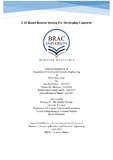| dc.description.abstract | Remote sensing is vital tool for academics and researchers in the field of agriculture, urban
planning, public health and many more. A trained eye can extract useful information where
any ordinary person will see an aerial picture. However, acquiring image directly from a
satellite is not always possible. Again, many do not have access to such data due their
limitations, such as time or funds. unmanned Aerial vehicle or uA v has proved itself a
reliable tool for aerial photography. Most of the aerial mapping systems utilizing UAV or a
remote controlled (RC) multi-rotor aircraft are costly and requires a specialist team to operate
it. Again cheaper, easy to fly and widely available remote controlled (RC) multi-rotor aircraft
are intended for children and hobbyists. They do not offer neither the quality nor the
functionalities required for a scientific project. in such specific cases, where aerial imaging
is required on low budget, only solution is to build a custom multi-rotor aircraft, tuned
precisely for scientific purpose. Unfortunately, it still requires a team who are skilled builders
and experience RC pilot. o u r project aims to bridge the gap that exists. o u r project goal is to
provide a platform for remote sensing based on UAV for developing countries such as
Bangladesh where budget is not abundant. we have devised a cost efficient way to build
semi-automated UAVs which is easy to operate for a novice RC pilot, having the necessary
functionality a researcher is likely to need to complete his experimentation or data collection.
o u r design utilizes local components to build the main frame for a quad copter to keep the
cost down, ArduPilot for high precision control to ensure the safety of surrounding people
and software interface which delivers cutting edge performance almost free of cost. For
control and communication link with our UAV, we used 2.54 GHz band, which is free of cost
and produces satisfactory result for operation within line of sight. To create a basic image
processing platform, we have used open CV, an open sourced, community maintained
computer vision library. Altogether we have been able to create a cost effective and efficient
system which can be easily adapted to any form of aerial imaging where both time and
resources are limited. | en_US |

